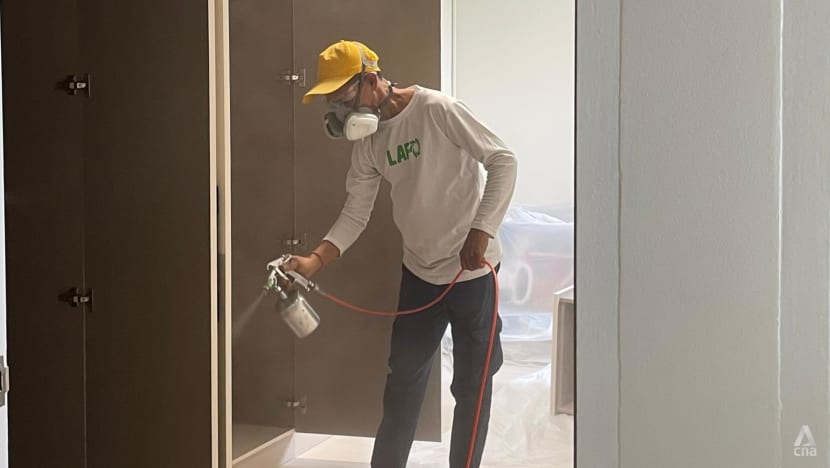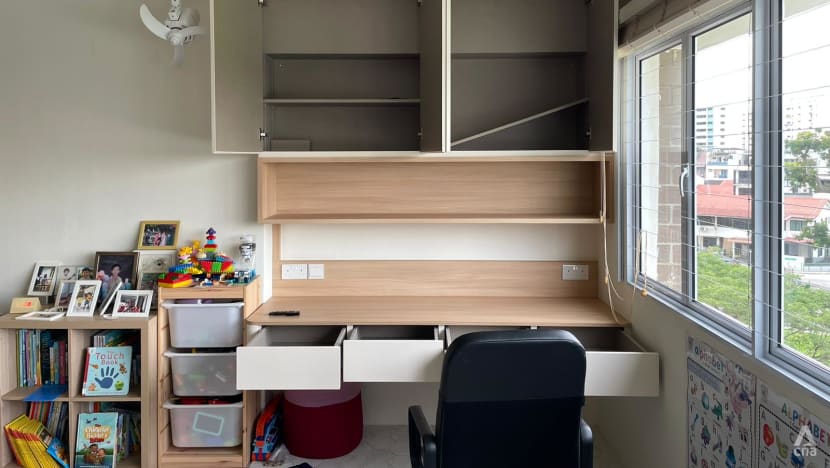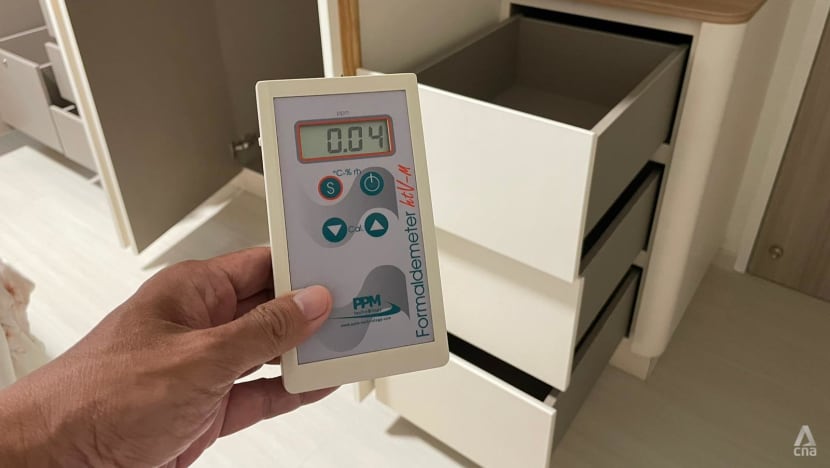‘The kids kept falling sick’: More Singapore home owners seeking help for high formaldehyde levels
A cancer-causing chemical was lurking among wooden cabinets and shelves in a Hougang flat, with the homeowner having no clue that her family was living in danger.

Workers from treatment firm LAF Environmental coat affected surfaces in Ms Ena Lee's home with a special solution that helps to disintegrate formaldehyde. (Photo: CNA/Sherlyn Seah)

This audio is generated by an AI tool.
SINGAPORE: When Ms Ena Lee, her husband and their two toddlers moved into their new five-room Hougang flat, what was meant to be their place of refuge soon turned into a nightmare.
“The kids kept falling sick quite often. At one point, my son was sick for a continuous two months,” she told CNA.
It took three months after their big move in January this year to finally realise what the problem was: A cancer-causing chemical called formaldehyde.
“My friend came over – she's actually an architect – when she opened up one of the cabinets, she was like, ‘Oh, strong formaldehyde smell!’” recounted Ms Lee, who is in her mid-30s and works as a chief operating officer at a food and beverage firm.
This scent – what some call the “new house smell” – is often present in wood furnishings.
But when someone goes closer, they could start experiencing a stinging sensation in their nose and eyes from what can be described as a strong sour pickle smell – a sure sign that something is wrong.
Ms Lee said that after her friend’s visit, she reached out to her interior design firm about the pungent smell, but the company kept telling her to “give it some time” and that it would “eventually go away”.
She also bought formaldehyde removal gels from e-commerce platform Shopee, along with activated charcoal to get rid of the smell.
When the problem persisted, she ended up contacting an air quality specialist. With the help of a formaldehyde meter, he soon discovered that the formaldehyde concentration levels were much higher than what is considered safe.
Workers were called in to coat affected surfaces with a special solution that helps to disintegrate formaldehyde.
After nearly seven hours of treatment that cost almost S$1,000, the concentration levels finally fell into the safe zone.
UP TO 70 PER CENT SPIKE IN CASES
While Ms Lee’s family can breathe easier now, more home owners like them have been seeking professional help to get rid of formaldehyde from their furniture.
Treatment firms CNA spoke to said that cases are on the rise compared with last year.
HelpToClean, which specialises in indoor formaldehyde removal, said it has seen a spike of up to 70 per cent. It now handles about 80 cases on average every month.
Another firm LAF Environmental, which treated Ms Lee’s flat, also saw about 30 per cent more cases and handles more than 20 cases a month now.
This comes as more people opt for wood furnishings that are both aesthetically pleasing and on the cheaper side.
These furnishings can be made from material like plywood, which is often coated with a laminate finish containing formaldehyde. Contractors may procure these materials from unknown sources overseas.
In high temperatures or hot weather, a process called off-gassing then occurs, where harmful chemicals – or volatile organic compounds like formaldehyde – are released from such products.
Formaldehyde is commonly used as it can make strong resins and glues.

HEALTH RISKS
In terms of the health risks of short-term exposure to formaldehyde, experts said that if concentration levels exceed certain limits, people may experience symptoms like skin irritation, eye soreness or eye irritation.
They could also contract bronchitis, have difficulty breathing, or suffer an asthma attack.
“For long-term effects, there are studies that have shown that formaldehyde is a carcinogen, so it can possibly cause cancers like nasopharyngeal cancer or leukaemia,” said Dr Jimmy Chew, family physician and CEO of OneCare Medical.
Research has shown that formaldehyde can disrupt cell membranes and destroy proteins in the body.
Dr Chew said he has seen few cases of formaldehyde exposure, but noted that some may not seek medical attention if their symptoms are mild.
“Most of the time, (patients) will say that after they move to the new house, they start experiencing skin itchiness or eye irritation,” Dr Chew added.
“But of course, I couldn’t definitely associate it with exposure, because after renovation, there could be a lot of other things like dust and other chemicals present.”
WHAT ARE THE RULES?
While Singapore has certain guidelines in place, they are not mandatory.
A national safety standard applies for indoor air-conditioned spaces, where formaldehyde concentrations should be limited to 0.08 parts per million. But this excludes non-air-conditioned places like Singapore homes.
At Ms Lee’s home, the concentration levels were 0.72 parts per million.
In response to CNA’s queries, the National Environment Agency (NEA) said it has been “closely monitoring” feedback regarding formaldehyde levels in homes arising from renovation works.
New rules kicking in from Jan 1, 2026, state that interior paints sold in Singapore must not contain formaldehyde.
Leading up to this, NEA said the public should look out for and use interior paints certified by the Singapore Green Labelling Scheme administered by the Singapore Environment Council, or the Singapore Green Building Product Certification Scheme administered by the Singapore Green Building Council.
Paints bearing these green labels are certified based on environmental sustainability, including the requirement to have no formaldehyde.
NEA noted that apart from interior paints, other building products such as composite wood products and adhesives may also emit formaldehyde.
“NEA is reviewing international best practices, guidelines and regulatory requirements before considering potential new controls,” added the statutory agency.
CONTRACTORS FACE ENFORCEMENT ISSUES
Meanwhile, contractors may follow a Green Mark standard that sets some limits on formaldehyde over a period of time. They can also use that platform to procure certified formaldehyde-free products or other green alternatives.
However, a professional engineer told CNA that it remains difficult to enforce any regulations, especially due to the nature of such products.
“When you assemble everything together, it's not just one single component. They are made up of so many different components together,” explained Dr Ang Keng Been, deputy chairman of the Institute of Engineers Singapore’s environment and water engineering technical committee.
“So it could be that 90 per cent of this material – they do not contain formaldehyde, but it’s just the 10 per cent that is causing the issue.
“(Because of this), it is more difficult to test for furniture when we want this application of regulation for this product finishing, or product furniture itself,” he added.

With more home owners buying furniture online, often from overseas platforms like Taobao, Dr Ang said it remains difficult to regulate materials procured for furniture. It can be tough for small suppliers and manufacturers to ensure quality control as well.
“I feel that contractors should actually (give priority) to the procurement and use of items from suppliers that contribute to reducing this environmental load, and also in a way to fulfil social responsibility,” he said.
Dr Ang expressed hopes that with increasing public awareness of better or greener furniture, more pressure can be placed on contractors when sourcing materials.
Ms Lee, the home owner, said she hopes that by speaking up, more people will be aware of the dangers of formaldehyde.
She also called for interior design firms to be responsible and acknowledge wrongdoings. The one she had hired remains unresponsive, even after she raised the concern of formaldehyde, she said.
“When customers reach out to you guys, you have to take responsibility and really work together with your client to solve this issue,” she added.
“It really doesn’t mean that because it is a norm, we should accept it, because it really isn't a norm. We can’t trivialise lives in general and health.”
What can you do to manage formaldehyde indoors?
- Ventilate indoor spaces by keeping windows and doors open. If possible, open windows and doors on opposite sides of the space to enhance cross-ventilation.
- Before moving into a new home, ventilate it for a period of time to reduce exposure levels, which are at their highest then.
- Indoor spaces where there may be high concentrations of formaldehyde should be ventilated as much as possible, especially during and right after the introduction or installation of products containing formaldehyde.
- Keeping fans on can also help to expel formaldehyde from living spaces.


















